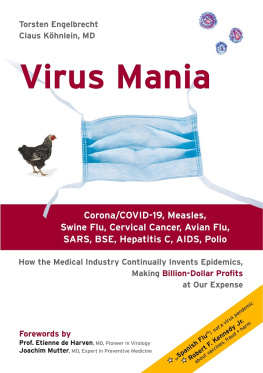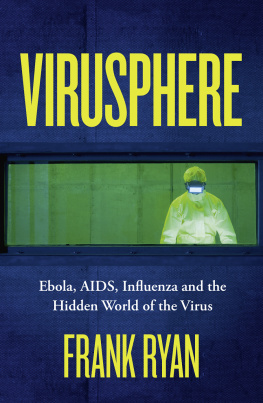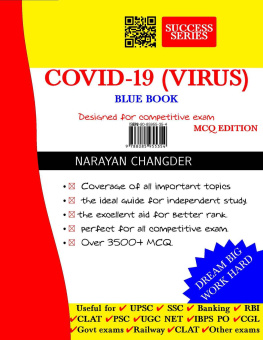For Christiane, Theresa, Johanna,
Catharina and Julius
For Anela, Liam, Maria, Karen and Eckart
and for all those who are committed to an
equitable and loving coexistence on this planet
2nd English Edition, 2020
Original German Title: Virus-Wahn
Published by emu-Verlag, Lahnstein
Torsten Engelbrecht, Claus Khnlein
All rights reserved
Translation: Estelle Laure Kamwa, Carina Hahn, Megan Chapelas, Danielle Egan
Editing: Torsten Engelbrecht, Carina Hahn, Danielle Egan, David Crowe
Printing, production and layout: BoDBooks on Demand GmbH, Norderstedt, Germany
Cover: Heike Mller, Robin Hahn
Photos (cover): Grsoy Dogtas
ISBN: 978-3-7526-9267-9
Table of Contents
About the Book
If one follows public pronouncements, the world is repeatedly afflicted with new terrible virus diseases. As the latest horror variant, the so-called coronavirus SARS-CoV-2 dominated the headlines. The population is also terrified by reports of measles, swine flu, SARS, BSE, AIDS or polio. However, this virus mayhem ignores very basic scientific facts: the existence, the pathogenicity and the deadly effects of these agents have never been proven. The medical establishment and its loyal media acolytes claim that this evidence has been produced. But these claims are highly suspect because modern medicine has pushed direct virus proof methods aside and uses dubious indirect tools to prove the existence of viruses such as antibody tests and the polymerase chain reaction (PCR).
The authors of Virus Mania, journalist Torsten Engelbrecht and doctor of internal medicine Claus Khnlein, MD, show that these alleged contagious viruses may be, in fact, also be seen as particles produced by the cells themselves as a consequence of certain stress factors such as drugs. These particles are then identified by antibody and PCR tests and interpreted as epidemic-causing viruses by doctors who have been inoculated for over 100 years by the theory that microbes are deadly and only modern medications and vaccines will protect us from virus pandemics.
The central aim of this book is to steer the discussion back to a real scientific debate and put medicine back on the path of an impartial analysis of the facts. It will put medical experiments, clinical trials, statistics and government policies under the microscope, revealing that the people charged with protecting our health and safety have deviated from this path. Along the way, Engelbrecht and Khnlein will analyze all possible causes of illness such as pharmaceuticals, lifestyle drugs, pesticides, heavy metals, pollution, stress and processed (and sometimes genetically modified) foods. All of these can heavily damage the body of humans and animals and even kill them. And precisely these factors typically prevail where the victims of alleged viruses live and work. To substantiate these claims, the authors cite dozens of highly renowned scientists, among them the Nobel laureates Kary Mullis, Barbara McClintock, Walter Gilbert, Sir Frank Macfarlane Burnet and microbiologist and Pulitzer Prize winner Ren Dubos. The book presents approximately 1,100 pertinent scientific references, the majority of which have been published recently.
The topic of this book is of pivotal significance. The pharmaceutical companies and top scientists rake in enormous sums of money by attacking germs and the media boosts its audience ratings and circulations with sensationalized reporting (the coverage of the New York Times and Der Spiegel are specifically analyzed). Individuals pay the highest price of all, without getting what they deserve and need most to maintain health: enlightenment about the real causes and true necessities for prevention and cure of their illnesses. The first step is to give up the illusion that the primary purpose of modern medical research is to improve peoples health most effectively and efficiently, advises John Abramson of Harvard Medical School. The primary purpose of commercially-funded clinical research is to maximize financial return on investment, not health.
Virus Mania will inform you on how such an environment took rootand how to empower yourself for a healthy life.
About the Authors
Torsten Engelbrecht works as a journalist in Hamburg. In 2009 he received the Alternative Media Award for his article The Amalgam Controversy. He was trained at the renowned magazine for professional journalists Message and was a permanent editor at the Financial Times Deutschland, among others. As a freelance journalist, he has written articles for publications such as Sddeutsche Zeitung, Neue Zrcher Zeitung, Frankfurter All-gemeine Sonntagszeitung, Rubikon, Freitag, Geo Saison, Greenpeace Magazin and The Ecologist. In 2010 his book Die Zukunft der Krebsmedizin (The Future of Cancer Medicine) has been published, with Claus Khnlein, MD, and two other doctors as co-authors.
Further information at www.torstenengelbrecht.com.
Claus Khnlein, MD, is a medical specialist of internal diseases. He completed his residency in the Oncology Department at the University of Kiel. Since 1993, he has worked in his own medical practice, treating also Hepatitis C and AIDS patients who are skeptical of antiviral medications.
Foreword I
by Etienne de Harven, MD
The Content of this Book Has To Be Read,
Quickly and Worldwide
The book Virus Mania by Torsten Engelbrecht and Claus Khnlein presents a tragic message that will, hopefully, contribute to the re-insertion of ethical values in the conduct of virus research, public health policies, media communications, and activities of the pharmaceutical companies. Obviously, elementary ethical rules have been, to a very dangerous extent, neglected in many of these fields for an alarming number of years.
When American journalist Celia Farber courageously published, in Harpers Magazine (March 2006) the article Out of controlAIDS and the corruption of medical science, some readers probably attempted to reassure themselves that this corruption was an isolated case. This is very far from the truth as documented so well in this book by Engelbrecht and Khnlein. It is only the tip of the iceberg. Corruption of research is a widespread phenomenon currently found in many major, supposedly contagious health problems, ranging from AIDS to Hepatitis C, Bovine spongiform encephalopathy (BSE or mad cow disease), SARS, Avian flu and current vaccination practices (human papillomavirus or HPV vaccination).
In research on all of these six distinct public health concerns scientific research on viruses (or prions in the case of BSE) slipped onto the wrong track following basically the same systematic pathway. This pathway always includes several key steps: inventing the risk of a disastrous epidemic, incriminating an elusive pathogen, ignoring alternative toxic causes, manipulating epidemiology with non-verifiable numbers to maximize the false perception of an imminent catastrophe, and promising salvation with vaccines. This guarantees large financial returns. But how is it possible to achieve all of this? Simply by relying on the most powerful activator of human decision making process, i.e. FEAR!
We are not witnessing viral epidemics; we are witnessing epidemics of fear. And both the media and the pharmaceutical industry carry most of the responsibility for amplifying fears, fears that happen, incidentally, to always ignite fantastically profitable business. Research hypotheses covering these areas of virus research are practically never scientifically verified with appropriate controls. Instead, they are established by consensus. This is then rapidly reshaped into a dogma, efficiently perpetuated in a quasi-religious manner by the media, including ensuring that research funding is restricted to projects supporting the dogma, excluding research into alternative hypotheses. An important tool to keep dissenting voices out of the debate is censorship at various levels ranging from the popular media to scientific publications.
Next page









